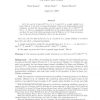Free Online Productivity Tools
i2Speak
i2Symbol
i2OCR
iTex2Img
iWeb2Print
iWeb2Shot
i2Type
iPdf2Split
iPdf2Merge
i2Bopomofo
i2Arabic
i2Style
i2Image
i2PDF
iLatex2Rtf
Sci2ools
103
Voted
DCG
2010
2010
On Lines and Joints
Let L be a set of n lines in Rd , for d 3. A joint of L is a point incident to at least d lines of L, not all in a common hyperplane. Using a very simple algebraic proof technique, we show that the maximum possible number of joints of L is (nd/(d-1) ). For d = 3, this is a considerable simplification of the orignal algebraic proof of Guth and Katz [9], and of the follow-up simpler proof of Elekes et al. [6]. Some extensions, e.g., to the case of joints of algebraic curves, are also presented. Let L be a set of n lines in Rd, for d 3. A joint of L is a point incident to at least d lines of L, not all in a common hyperplane. A simple construction, using the axis-parallel lines in a k
Related Content
| Added | 10 Dec 2010 |
| Updated | 10 Dec 2010 |
| Type | Journal |
| Year | 2010 |
| Where | DCG |
| Authors | Haim Kaplan, Micha Sharir, Eugenii Shustin |
Comments (0)

